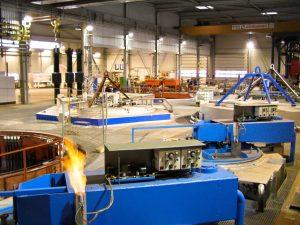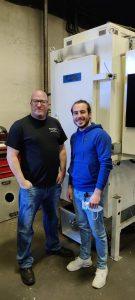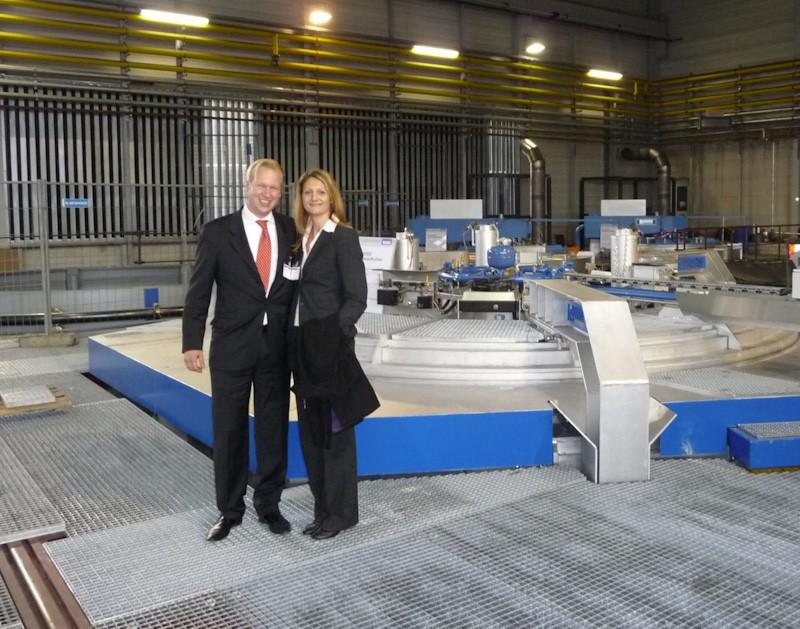Jörn Rohde
Rohde Gmbh
Jörn can you please tell us a little bit about yourself? For instance; your background, how you first got involved in the heat treating industry and how you came to become the President of Rohde Gmbh?
“I have been working with my father in the company since I was a child. My tasks have grown over the years. It started as a child with sweeping the yard, cleaning machines, helper work and with the start of my apprenticeship as an industrial mechanic (in another company) I could already work independently on furnaces in production and go on assemblies during my vacation. During my studies I was able to enter the design department and later, with my degree as a Diplom Ingenieur (graduate engineer in mechanical engineering), I was able to take over the management of this department. Later I became the managing director of the company. I can say that I have been building furnaces for 35 years and that I am now in my mid-forties.”
I know Rohde GmbH has grown quite a bit over the years. Can you share with us the size of the company, how many employees you have, and annual sales?
“We are a classic medium-sized family business. We employ 25 people and have an annual turnover of approx. 4 million euros. Our ambition is not to grow at any price and employ more people, but to keep improving our equipment and to offer our customers the best solutions worldwide with our long-established team of employees. We want to remain a family business and hope our two sons will follow the tradition and continue the company.”
What products do you have to offer and if you don’t mind me asking what product is your number one seller?
“We supply retort furnaces in various designs. Shaft furnaces, chamber furnaces, bell furnaces and our favorite, special designs. We love the challenge and new customized developments are definitely one of our strengths. Our best seller, however, is our SRU (Salt Recovery Units). These were designed by my father, a design which we continue to upgrade and we have these systems installed around the world.“
I know you have been quite successful with your line of vacuum nitriding systems, please share some details with our readers.
“We are an absolute premium manufacturer in the field. This applies to all important areas of furnace technology: lowest temperature differences, best gas distribution in the work zone, low wear due to best components also for purchased parts. We are also the market leader in energy savings. In Germany, we can undercut our market competitors in terms of price after only three years of use. After less than 15 years, the investment is recouped through the energy savings. Germany is certainly a special case due to the high energy costs, but anyone who values sustainability cannot ignore us. Direct comparisons to other market companions from Germany show that our furnaces are the most energy efficient in the market. We also have strong partners in the field of process development, such as the Leibnitz Institute in Bremen, with whom we always develop state of the technology through various research projects.”
I’m sure you have built a lot of highly specialized furnaces over the years. What’s the most interesting furnace project you’ve worked on?
“Due to the custom designed furnaces we manufacture, it is really not an easy question, as many of the furnaces were special. There is a smaller system that had to fit into a freight elevator in China including all aggregates, because we could not enter the country due to the entry regulations. Or for example plants like our Bell hardening center which hardens fully automatically and quenches in oil or salt. At the moment, special systems for catalysts for hydrogen production are a new task for us, because the product in the furnace has other properties as known. As a graduate engineer, I look for the technical challenge. The higher the demand of the customer, the more fun we have solving the challenge.”
 Is it true you have built the largest pit carburizing furnace in Europe?
Is it true you have built the largest pit carburizing furnace in Europe?
“Yes, no one else wanted to or could build this furnace and we took on the challenge. This project was very exciting. No one had ever built a retort with a diameter of 5.5 meters (16.5’) before. As far as I know, such large furnaces were always built without a retort. We love the challenge! (Editors note; This furnace is located at commercial heat treater “Reese” in Germany and is very impressive).”
There’s a rumor floating around that you are partnering up with McLaughlin Furnace Group to provide Salt Recovery Units (SRU’s) in North America. Can you tell us a little more about the partnership and about Salt Recovery Units (SRU’s) in general?
“We have a good product and Jeff has a great company and can respond quickly in North America. I think in terms of product, quality and service, we have the same high standards. It is easy to find a salesman in any country, but in my opinion you need more. The SRU business in North America is doing well, but by building in North America we will be able to save on the transportation costs and long delivery times. Together we can simply achieve more. In the same way, we will support the McLaughlin Furnace Group in Europe. We can both benefit from sharing our existing resources and I look forward to working with McLaughlin.”
 Is there a certain style of furnace that the SRU’s are ideal for? For example, does it make more sense to put an SRU on a batch furnace versus a continuous furnace? Can you provide some details on how these units operate?
Is there a certain style of furnace that the SRU’s are ideal for? For example, does it make more sense to put an SRU on a batch furnace versus a continuous furnace? Can you provide some details on how these units operate?
“The more salt a customer buys, the more sense an SRU makes, regardless of the furnace type.
Basically, in continuous furnaces with small parts and high surface area, the salt discharge from the quench tank is the highest. Thus, continuous flow furnaces with salt quenching are ideal for using an SRU.
The function is simple: We continuously remove water from the wash tank. In the SRU, the wash water is evaporated, the salt is separated from the carbonates and impurities, and the pure, liquid salt is added back to the quench tank either directly or solidified into salt blocks. Depending on the carbonate content of the salt, these must be removed from the unit. Initially, this is done relatively often in the salt bath until the salt returns to its original quality. But the loss of salt is significantly reduced and the quality of the product increases! The product is good for the environment, but even better for the wallet.”
We all know how much heat treaters hate ongoing maintenance when it comes to their furnaces, what’s the maintenance like for an SRU?
“Our customers need to clean the plate pack in which the contaminants settle. Turn off the unit, wait until it is cold enough to work safely, remove the plate pack and remove contaminants, then reinsert the affected plates and turn it on! That’s it. Changing gaskets, thermocouples or heating elements happens every few years. So maintenance is kept within limits.”
This is an unfair question because there are a lot of variables involved. What would be a standard ROI for an SRU unit? With the price of salt these days I can imagine the ROI has improved a lot!
“It is true that many variables play a role here, but above all it the amount of salt which the end user is replacing every year. So it is a very simple calculation for any heat treater to determine their individual ROI. 99% of the salt which ends up in the wash system is recovered and this is salt which does not need to be replaced. The only thing that contrasts with this is the cost of electricity used by the SRU and it is relatively modest. So if the system makes sense in Germany which has some of the highest electricity costs in the world it is fantastic for the American market.”
Jörn I very much appreciate the time today and look forward to seeing you at the HK22 Heat Treatment exhibition in Cologne, Germany in October of this year. Jordan Montgomery

